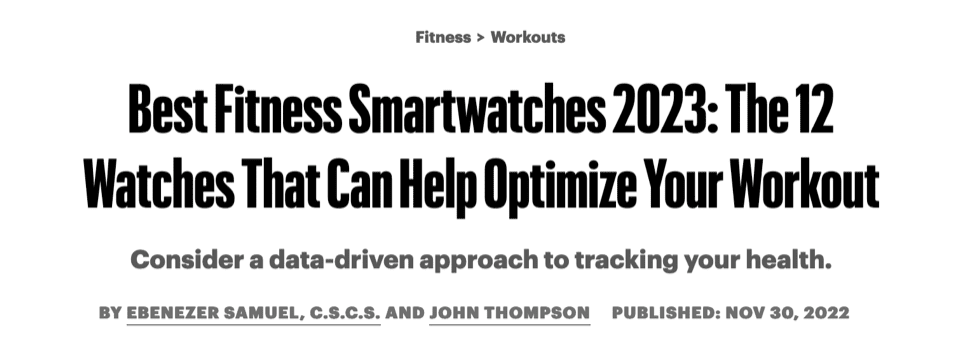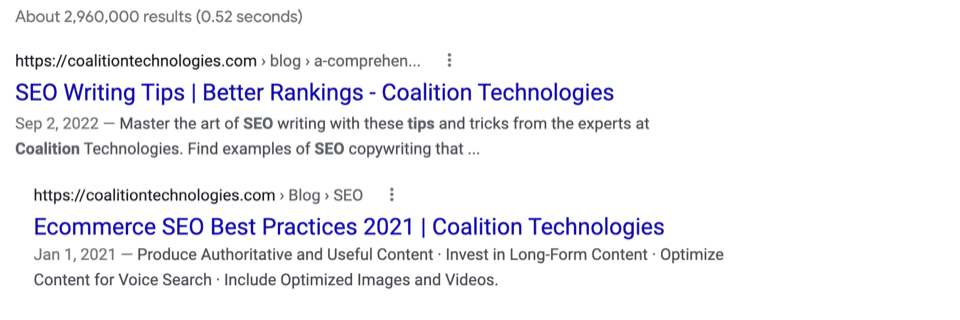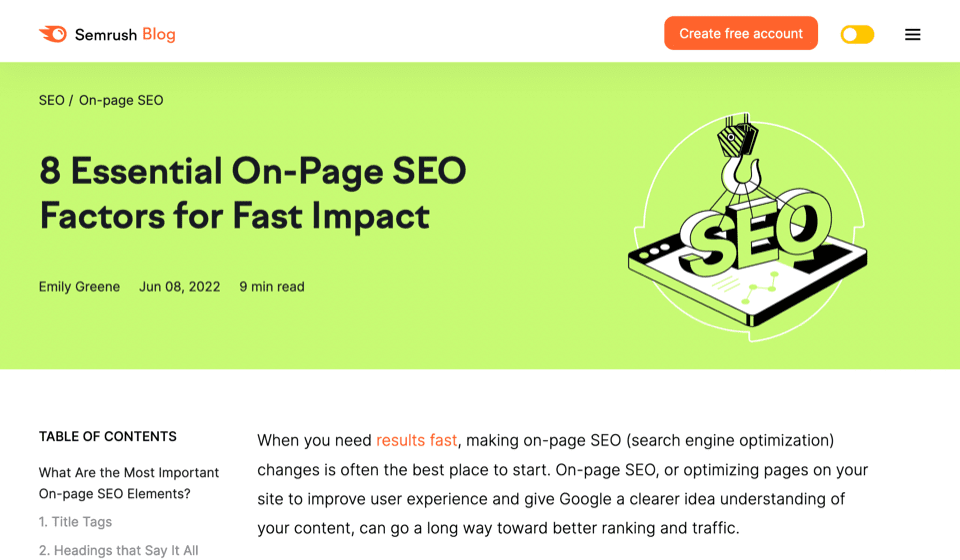
If there’s one constant about SEO, it’s change. Search engines continually update their algorithms, and best practices evolve from one year to the next. It’s always great to assess where you are with your marketing efforts. This will help you stay ahead of the curve and keep up with major shifts in the industry.
Especially in light of Google’s Helpful Content Update, some SEO tips from a few years ago may no longer be applicable, making now the perfect time to review your content and site structure. Successful SEO isn’t just about reaching bots to index a page—your content needs to provide fresh, meaningful insights to your site’s visitors.
According to the most recent Winterberry Group estimates, online media spending in the United States hit about a quarter trillion dollars in 2021. And with 49% of marketers sharing that organic search offers the highest ROI of any form of marketing, you’ll have to get in the ring to compete for consumers’ dollars and not sit on the sidelines.
Here’s your deep dive into our on-page SEO checklist so you can maximize the results of your optimization.
Table of Contents
- 1 What Is On-Page SEO All About?
- 2 Everything You Need for Your 2023 On-Page SEO Checklist
- 2.1 Optimize Titles & Headings
- 2.2 Optimize Meta Descriptions for Both Search Engines and Readers
- 2.3 Write Informative and Engaging Content That Is Based on SEO Guidelines
- 2.4 Optimize Images for Better Search Engine Rankings
- 2.5 Include Relevant Internal Links and Link to High Authority, Non-Competing Sites
- 2.6 Optimize URLs
- 2.7 Optimize Old Content on Your Website
- 3 Conclusion
What Is On-Page SEO All About?
On-page SEO is the process through which we tweak existing content or write new content, add tags and internal links, and rectify the technical issues on the website which can impact the crawling process. We can compare it to the products and display layout in a store—this is what customers see, and it’s an important pillar of what makes your business successful.
On-page SEO involves the optimization of certain elements to increase organic traffic. These elements include keywords, headings, images, alt text, videos, meta descriptions, title tags, and more.
This is different from off-page SEO, which increases site visibility on a search engine results page without doing anything on your website. This includes link building efforts and social media marketing; these strategies can drive traffic to your site, but they don’t directly rely on the content of your most important pages.
On-page SEO also differs from technical SEO, which refers to optimizing your website to help the search engine spiders crawl it more effectively—a sitemap or robots.txt file would fall into this category.
In many respects, on-page factors are the most important. Even if your site is expertly designed or has thousands of backlinks, poor content will drag down your conversion rate optimization (CRO) and likely lead to users bouncing. The benefits of adhering to items on your on-page SEO checklist are:
- Higher search rankings
- Advanced crawl rate
- Improved brand awareness
- An increase in conversions, resulting in increased earnings
With more than 50% of US shoppers reporting they’ll research products with a search engine before making a purchasing decision, you want to make sure your website ranks highly for a search query to get some sales.
Everything You Need for Your 2023 On-Page SEO Checklist
Your business will need to include the following on-page SEO elements in its checklist. From the optimization of images to including relevant and helpful links, here’s what you need to get on-page SEO right in 2023.
Optimize Titles & Headings
This one is easy to let slide, especially if you make frequent updates to your pages. Maybe a title tag made sense for an old version of the page, or you’ve since chosen a new keyword to focus on but never updated the headline. Sometimes you just need to review that your titles and headings are well-crafted, attention-grabbing, and adhere to SEO best practices.
To grab users’ attention, your on-page SEO checklist should include writing easy-to-read headlines that include benefits for your readers.

Take a look at this excellent example of headline optimization from Men’s Health. This works for on-page SEO by capitalizing on keywords and introducing a list—data shows that list posts boost organic traffic by 80%.
For best practices, your h1 headlines should follow these tips:
- Use a primary keyword.
- Be unique to the page and your site.
- Match the user’s intent.
- Ideally, be 65 characters or less.
For instance, you don’t want two different pages on your site containing lists of the same products. An informational page should use knowledge-related keywords like learn or discover.
Optimize Meta Descriptions for Both Search Engines and Readers
Your 2023 on-page SEO checklist should also include meta descriptions. It’s helpful to think of a meta description as a summary of the page, but Google also says that their algorithm will sometimes use a meta description to generate a featured snippet in search results.
If you’re answering a question or providing a tutorial, the meta description should share the information most relevant to the user. It’s best practice to use a compelling hook and action verb to entice the user to click. For example, these two meta descriptions signal that they will provide valuable information to the reader and begin with attention-grabbing calls to action.

You should keep your meta description between 150 – 160 characters. If your meta description is too long, it won’t show up in its entirety on the SERP, hurting your chances of searchers understanding the content of your site.
While Google states that they aren’t used as a ranking signal, it helps to write meta descriptions that are descriptive, relevant, and attention-grabbing. Optimizations of meta descriptions are often overlooked, but they are an important part of on-page SEO, as they can help improve click-through rates when written well.
Write Informative and Engaging Content That Is Based on SEO Guidelines
If you’re running an ecommerce website or other type of business, you may not seriously consider creating content beyond what you’d display on your product and service pages. However, adding a blog with relevant and engaging content is an important component of on-page SEO.
Content should be written from an authoritative and trustworthy position. Following the acronym E-E-A-T (Experience, Expertise, Authority, and Trust), Google has placed further emphasis on content that comes from first-hand experience. These factors are determined by search quality raters to determine the effectiveness of search results. While E-E-A-T is not directly used to decide your page’s ranking, it is still a crucial part of SEO.
Following these tips will help make your posts more meaningful to your audience:
- Write in active voice: Compared to passive voice, the active voice forces you to use fewer words to write in an engaging and captivating manner.
- Quality over quantity: Ensure your content is written well and contains relevant and helpful information your readers will value.
- Write for humans: This means writing naturally and not using keywords awkwardly in the hopes of increasing blog traffic. Avoid an overreliance on AI-driven text generators. Human-authored content sounds more authentic and generally performs better.
- Vary formatting: Readers get bored when they come across massive blocks of text. To avoid this, write short paragraphs, add bullet lists, and break up text with engaging and visually appealing images.
- Incorporate trends: Hopping on the latest trends can give your blog much-needed visibility, but doing so correctly matters. Ensure you create blog content that incorporates trends yet manages to provide relevant and helpful information to your readers.
This should definitely be part of your on-page SEO checklist and will most likely drive search traffic to your website—the top of the conversion funnel is about awareness and product discovery, so the more information you share about your products and services, the more likely you are to increase your conversion rate.
And if you needed more convincing: Content is listed as one of the top three factors for ranking on Google’s SERPs.
Optimize Images for Better Search Engine Rankings
Images, like all visual media, are an integral part of content. They make websites attractive and easier on the eyes. Plus, they help convey the message of your content in an engaging way.
However, images can also take up a lot of space on your website, which can slow it down and ruin your users’ experience. This is why it is important for your on-page SEO checklist to include the optimization of image file sizes by reducing them.
Make sure you avoid slow webpages by using tools like Google’s PageSpeed Insights to ensure your page load speed is fast. When you perform page speed optimizations as part of on-page SEO and make your pages load faster, you make browsing your site easier, which greatly enhances their user experience.
It’s also worth taking a moment to see if any of your images need updating. Especially in ecommerce, you don’t want last year’s version of a product to still be the image for this year’s item description.
Include Relevant Internal Links and Link to High Authority, Non-Competing Sites
Ensure you include the first internal link towards the end of the introduction of your webpage. This way, if a user decides to leave shortly after reading your page they can click on an internal link that will lead them to another page on your website. Blog readers spend an average of about 37 seconds on an article—but that number’s misleading.
Of course, if someone finds your content valuable, they will stay much longer than half a minute. What drags the average down are quick bounces, so you want to make sure that visitors aren’t leaving your page to visit a competitor’s site.
Furthermore, ticking off linking to relevant internal pages as part of your on-page SEO checklist can help your site build topical authority around a given topic. It also signals to Google what your page is all about.

This introduction from Semrush’s blog is an excellent example of including relevant internal links as part of on-page SEO. The position and optimization of the first internal link is such that if a reader is going to leave the webpage within the aforementioned 37 seconds, they’re more likely to click on the internal link indicated by the orange text (“results fast”) and still land on Semrush’s blog.
Optimize URLs
As part of your 2023 on-page SEO checklist, you should create shorter, more relevant URLs that are easy to remember and will help users understand what your site is about. In addition, an optimized URL will tell Google (and other search engines, in general) information about the relevance of your content.
The optimization of URLs as part of your on-page SEO strategy makes them more user-friendly for readers. This, plus including targeted keywords in your URLs improves the structure of your URL, which is also a form of technical SEO.
- Incorporate Schema Markup to Your Site
Schema markup is structured data on your page that search engines read to understand the content on your website. Generally, there are different types of schema used online.
Some excellent schema types to use in your on-page SEO checklist strategy are:
- Article schema: Search engines use this markup language to better understand your articles and blog posts, and possibly enhance their visibility in search engine results pages.
- FAQ schema: These help answer questions readers may have and can enhance the appearance of your results in the SERPs with an organized layout, usually in tabular format. It’s for this reason that FAQ schema is an excellent form of optimization in on-page SEO.
- Product schema: If you’re an ecommerce site, product schema is an invaluable way to improve the appearance of your products in SERPs and possibly increase click-through rates and conversions. Examples of this included those “Check Price on Amazon” buttons you see on sites that use affiliate marketing or ordinary buttons with price tags already on them.

What also makes schema markup interesting is that you can customize the look and appearance of your webpage with just a few (okay, maybe not just a few) lines of code. If you do need some assistance with the technical side of your page design, get in touch. We’re happy to help.
Optimize Old Content on Your Website
You may think there is no point in improving or optimizing old content, but the data shows otherwise. Optimizing your blog posts with new content might increase organic traffic by up to 111%.
Your on-page SEO checklist should definitely include incorporating all the above points, as well as adding new and correct information to your content.
If you have last year’s travel guide to the best summer vacation destinations already live on your site, consider adding to that page and updating it rather than reinventing the wheel. This allows you to build on the page’s previous ranking and traffic while still providing fresh insights to your readers.
Conclusion
On-page SEO done right delivers incredible results for your business. Now is the perfect time to incorporate our on-page SEO checklist into your business’s overall SEO strategy.
At Coalition Technologies, we understand the importance of on-page SEO and can help you set up your business for success in 2023. We’ve worked with well over 1,000 clients and generate close to 700% more revenue than the average agency in our industry.
If you’d like to see more of what we’re made of, check out our case study portfolio. We’re the best at delivering data-driven marketing services that will help your business thrive. Get your free proposal from our online marketing team today.


